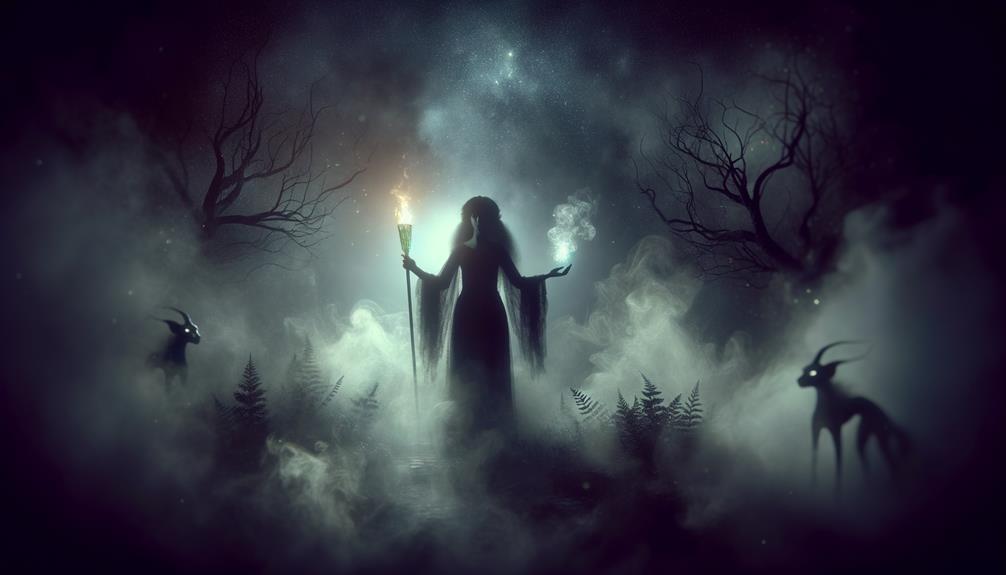Hecate captivates as a powerful mythological figure embodying the archetype of the witch at life's crossroads. Her origins trace back to Ancient Greece, yet her traits intertwine with Egyptian and Anatolian deities. Frequently depicted with torches or three heads, she represents the moon's phases, guiding us through veiled realms. Sacred animals like dogs and polecats reflect her mystical essence. At crossroads, worshippers leave offerings, seeking her protection and guidance. Hecate's influence persists in modern witchcraft, emphasizing transformation and choice, bridging the mundane and mystical spheres. Her profound impact unveils fascinating themes.
Origins of Hecate
Hecate's shadowy origins interweave diverse cultural threads, hinting at pre-Greek, Egyptian, or Anatolian roots. Tracing ancient texts, she first emerges during Ancient Greece's Archaic age in Hesiod's Theogony. This triple-bodied goddess embodied a versatile nature, aligning with her connection to transitional realms—those shifting boundaries between the familiar and unexplored.
Mythology veils Hecate's birth in obscurity. Some scholars theorize her veneration migrated from older traditions. Her nuanced roles and attributes resonate with counterparts from Egyptian and Anatolian pantheons, lending credence to this notion. Yet her profound impact on Greek mythology remains undeniable, particularly as a deity associated with crossroads and change.
Ancient sources depict her as a commanding presence, aiding Demeter in the Homeric Hymn to Demeter, wielding a torch through darkness. By 430 BCE, her cult had firmly taken root in Athens. Though few sanctuaries were dedicated solely to her on the Greek mainland, epithets like Enodia, Trodia, and Propylaia highlighted Hecate's pivotal role in navigating the ancient world's shifting boundaries.
Divine Duties
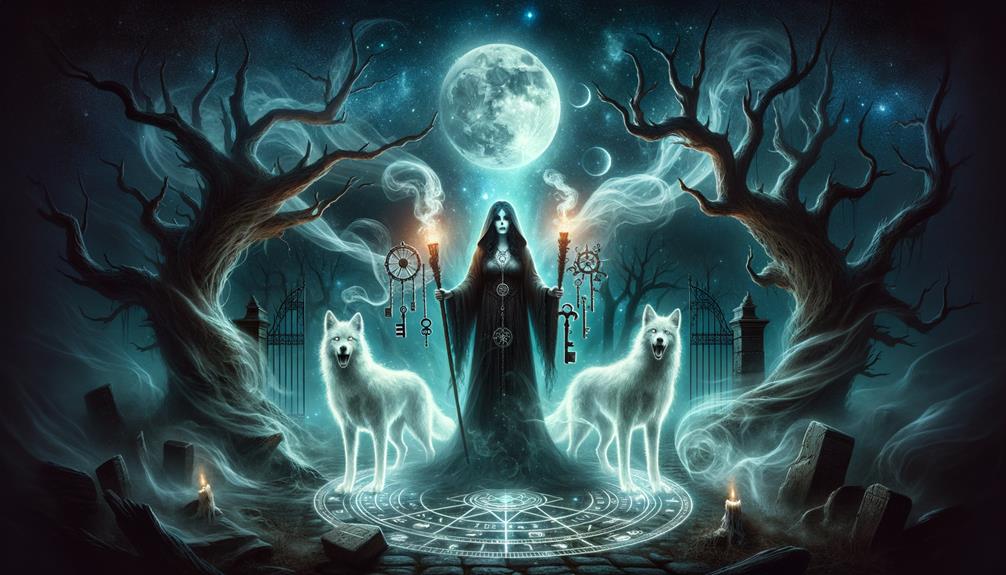
Hecate, the Greek goddess, wielded immense influence across diverse realms. Her divine responsibilities encompassed sorcery, the night, and transitional spaces. Regarded as the foremost authority on witchcraft and necromancy, her ties to the moon enhanced her mystical aura.
Hecate held dominion over thresholds and life-altering moments. As the guardian of entrances and crossroads, she personified protection during transformative junctures. Her titles like Enodia and Propylaia affirmed her guidance through pivotal decisions.
Mythological interpretations portray Hecate as a triadic figure with three faces or forms, symbolizing her command over past, present, and future. This triplicity mirrored the moon phases while underscoring her role in navigating mortal and immortal realms.
Depictions of Hecate
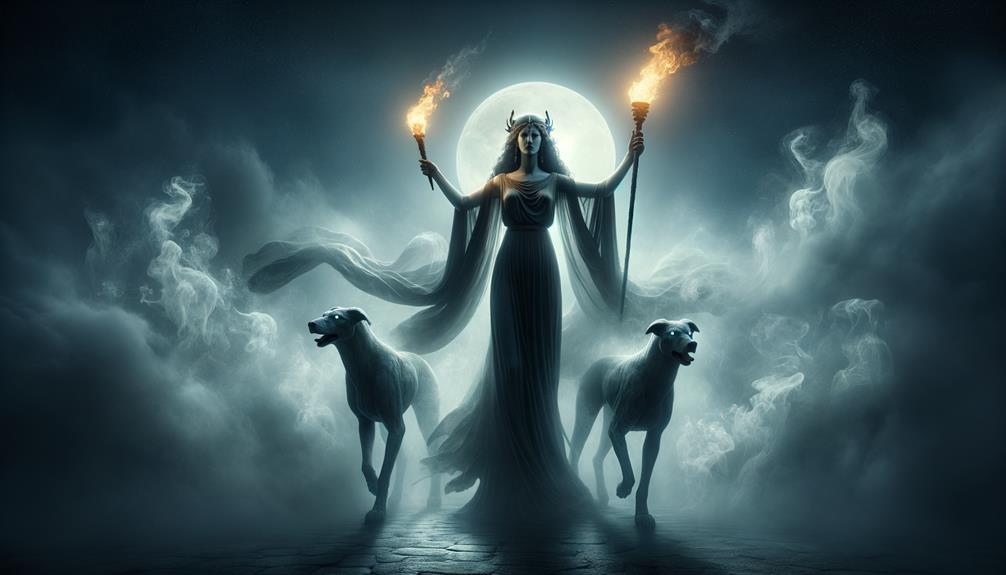
Depictions of Hecate often reveal her profound ties to liminality and transformation, embodying archetypal themes of light and dark through blazing torches and triple forms. Greek pottery frequently showcased Hecate holding torches, symbolizing her role as a goddess of light and night. Her liminal nature materialized through her triple-formed goddess representation, signifying her dominion over crossroads and boundaries.
Votive statues commonly featured Hecate with the Graces dancing around her, highlighting her divinity and magic. This imagery underscored her connection to celestial and chthonic realms. Hecate's association with dogs reinforced her underworld protection role and nocturnal bond, often depicted with a pack.
During late antiquity, Hecate transformed into a single goddess with three heads. This evolution accentuated her trifold nature, encapsulating her varied powers and domains. Hecate's rich iconography provides insight into her complex mythological role, bridging worlds and guiding souls through life's mysteries.
Sacred Animals
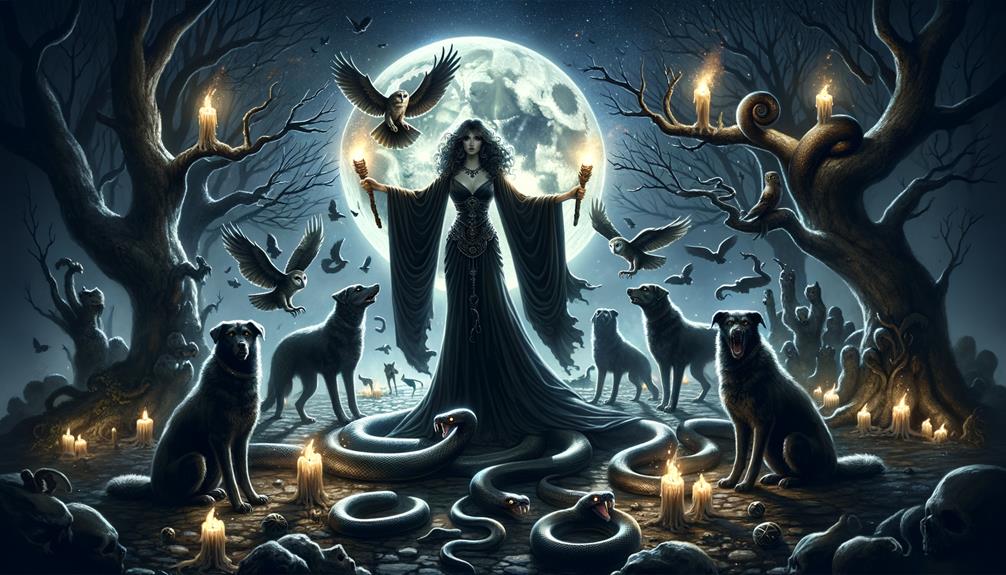
Hecate's sacred animals hold profound symbolic meanings that reflect her divine essence. Dogs mirror her role as a guardian, guiding souls through life's transitions. Meanwhile, the polecat represents the mysteries of transformation and the nocturnal realm. By exploring these animal companions and their ritualistic significance, we gain deeper insight into Hecate's multifaceted connection with the natural and spiritual worlds.
Symbolic Animal Companions
Hecate's sacred animals—dogs, polecats, and red mullet fish—shed light on her mystical connections to the underworld, transformation, and liminality. The black she-dog at her side symbolizes her role as a guider through the night and her affiliation with the moon. This sacred companion transcends simple company; it guards and protects, mirroring Hecate's own role as a navigator of shadows and crossroads.
The polecat, or weasel, doubles down on her ties to the underworld and metamorphosis. This elusive creature's ability to slip between spaces channels Hecate's liminal goddess status, existing between the physical and metaphysical realms. The polecat reminds us of Hecate's power to facilitate change and oversee transitions.
Ancient Athenians offered red mullet fish as sacrifices, highlighting the enduring cultural significance of her sacred animals. This aquatic tribute underscores her dominion over the sea's mysteries, parallel to her governance of the underworld. Together, these symbolic companions capture Hecate's multifaceted nature, reflecting her diverse powers as a goddess of transformation, night, and the guiding light through darkness.
Mystical Creatures' Meanings
Hecate's mystical creatures reveal deep symbolism and her prowess over life's transitions. Dogs, especially black ones, highlight her bond with the underworld – steadfast guardians guiding souls. The weasel reflects her stealthy magical abilities, adapting through change. The red mullet fish, used in Athenian rituals, represents her protective role during transformations, leading seekers through life and death's phases.
These sacred animals embody Hecate's multifaceted nature. Dogs, weasels, and mullet fish interweave narratives of protection, transformation, and profound magical skill. Each creature mirrors an aspect of the powerful crossroads goddess's intricate identity.
Ritual Uses Explained
Hecate's animal companions – dogs, weasels, and red mullet fish – embody her core symbolism in rituals. In ancient Greek religion, these creatures weren't mere offerings but manifestations of her elemental powers. They represented guardianship, metamorphosis, and the aquatic realm's significance.
Dogs symbolized loyalty, sacrificed to invoke Hecate's protection. Weasels, stealthy and cunning, embodied transformation – essential for traversing life's transitions. Red mullet fish, used in Athenian rituals, highlighted water's primacy. Depictions with polecats signified her connection to the spirit realm, reflecting her role as a guide through profound changes.
Hecate's association with these animals underscored her multifaceted nature – three forms unified as the goddess of magic. Rituals with these creatures revealed the belief in her ability to cross boundaries between mortal and divine, seen and unseen realms. Each offering enriched the understanding of her vast, elemental power.
Worship Practices
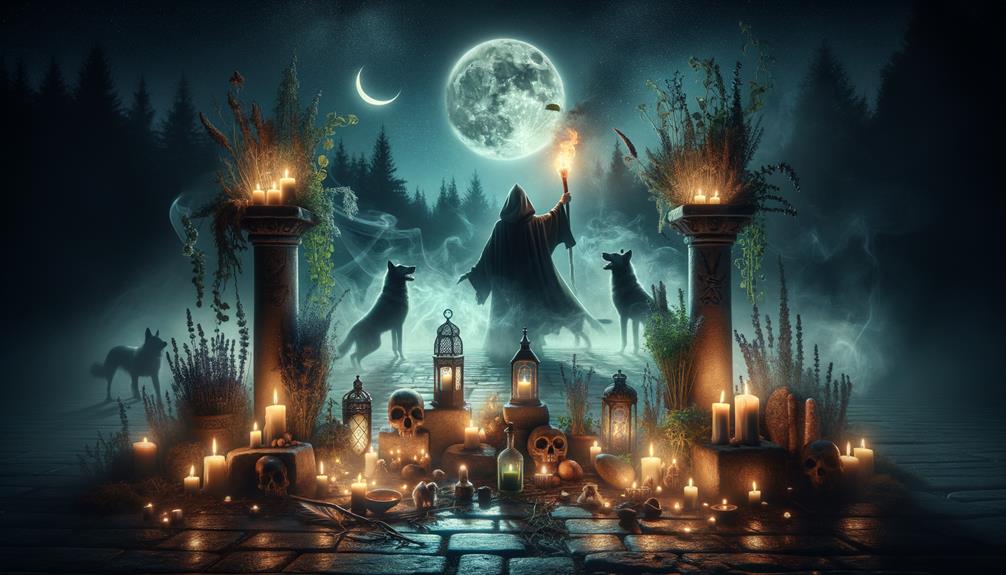
Devotees often gather at crossroads, leaving offerings and lighting candles to honor Hecate's profound ties to transitions. These practices reflect her role as the guardian of thresholds and journeys. Offerings like garlic, honey, incense, and keys invoke her protection and guidance. The crossroads symbolize Hecate's dominion over choices and the unknown.
Rituals typically occur during the new moon phase when the night is darkest, underscoring Hecate's association with magic and mysticism. This phase is believed to be when her powers peak, making it an opportune time to seek her aid. Devotees might chant invocations or recite hymns to call upon her presence.
Creating personal altars is another common tradition. These altars feature symbols: torches for illumination and guidance; dogs as her sacred animals; and lunar imagery highlighting her connection to the moon's cycles. Through these rituals and symbols, followers deepen their bond with Hecate's wisdom and transformative energy.
Modern Reception
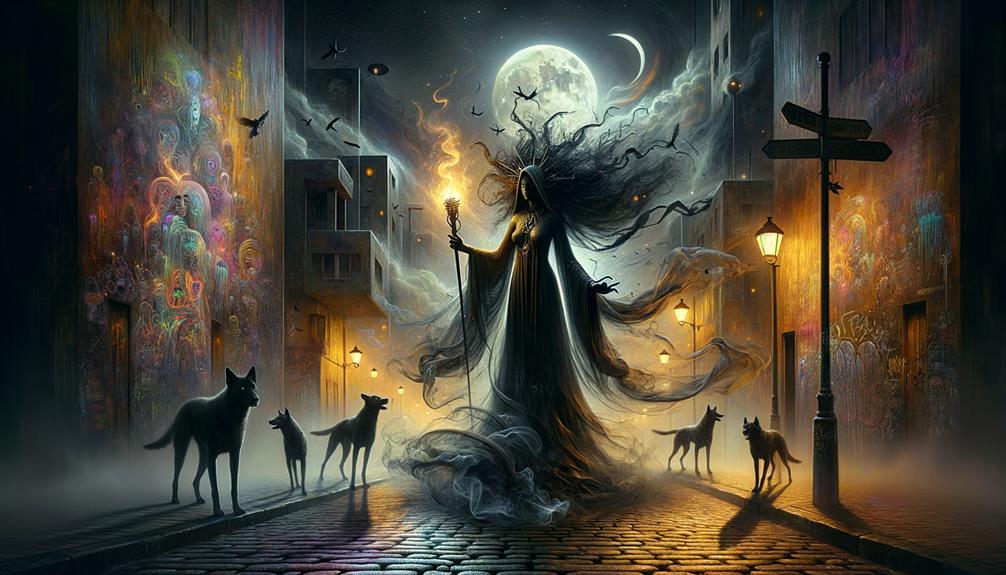
In our modern age, Hecate's ancient archetype strikes a chord, manifesting both in contemporary pagan practices and mainstream entertainment. Her symbolism of life transitions and uncertainty speaks to those seeking empowerment and guidance through life's complexities. This revival underscores her enduring relevance, bridging mythology with our search for meaning and personal growth.
Pop Culture Influence
TV shows and video games leverage Hecate's symbolism – tapping into her witchcraft associations for modern narratives. The goddess appears in 'Chilling Adventures of Sabrina' and 'American Horror Story: Coven,' resonating with contemporary magic practices and ideals like female empowerment. Her archetype aligns with beliefs upheld by pagan and Wiccan communities.
Games like 'God of War' and 'Hades' depict Hecate's mystical powers, integrating ancient mythology into today's interactive experiences. Her image captivates audiences across media – a compelling representation of mystery and strength in pop culture.
Contemporary Witchcraft Practices
Hecate, the archetype of transformation and transition, has gained prominence in modern witchcraft practices. Witches invoke her during rituals centered on personal growth and navigating life's crossroads. Her presence bridges the ordinary and mystical realms, embodying magic while guiding followers through periods of change.
Contemporary witches revere Hecate for her association with liminality—those in-between spaces where transformation thrives. They seek her protection and wisdom in divination rituals, using symbols like keys and torches to illuminate hidden truths and illuminate the path ahead. The crossroads, a significant liminal site, often becomes a sacred space for such rituals, symbolizing choices and new beginnings.
During the Dark Moon phase, Hecate's energy is channeled for introspection and shadow work. Witches offer garlic, keys, and other tokens to honor her, drawing upon her power to navigate the unseen realms. Through these practices, Hecate facilitates personal empowerment, encouraging the embrace of intuition and the mysteries of the night. Her enduring presence in modern witchcraft reflects humanity's timeless need for guidance amidst transformation.
Frequently Asked Questions
Is Hecate the Goddess of the Crossroads?
Hecate wholly personifies the pivotal crossroads in Greek myth – she's the unmatched guardian and facilitator of life's defining intersections where choices forge new paths. Whenever stories reach a crucial turning point, you'll find Hecate guiding characters through their transition. Her domain encompasses those consequential junctures that demand discernment and courage to determine what lies ahead.
Is Hecate the Goddess of Witches?
Hecate holds immense mythological significance as a goddess connected to witchcraft and the occult. While not singularly the witches' goddess, her symbolism aligns closely with magical practices and the supernatural realm. She embodies archetypes deeply ingrained in witchcraft beliefs across cultures. Many modern witches pay homage to Hecate, revering her as a powerful figure within their craft.
What Does Hecate Want the Witches to Do?
Hecate expects us to respect her through rituals and offerings, look to her for guidance, and grow our magical talents. We must maintain sacred places, like crossroads, and carefully balance light and darkness, taking this responsibility seriously.
Is Hecate Evil or Good?
Hecate resists straightforward moral labels, embodying duality much like mythological figures do. Her crossroads symbolism and witchcraft ties reveal a complex persona that transcends simplistic good or evil categorization.

